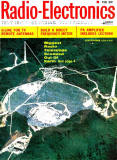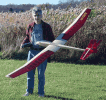|
June 1964 Radio-Electronics
 [Table of Contents] [Table of Contents]
Wax nostalgic about and learn from the history of early electronics.
See articles from Radio-Electronics,
published 1930-1988. All copyrights hereby acknowledged.
|
 The National Science Foundation's 1000-meter
Arecibo radio telescope,
carved into a Puerto Rico mountain valley, was commissioned on November 1, 1963.
Justification in funding the colossal project was partly from the Department of
Defense because of a need to characterize the Earth's upper atmosphere. Satellites
and looming threats of soon to be developed ICBM traffic were of prime concern.
One of the renowned uses of the Arecibo radiotelescope was when
Carl Sagan's team
transmitted a "we are here" message toward the M13 globular cluster in the
constellation of Hercules in 1974.
The amount of research and data collected over the ensuing six decades has been
invaluable from both communications and astronomical perspectives. Tragically, on
November 7, 2020, the dish suffered a
catastrophic
mechanical failure in the suspension supports, resulting in irreparable damage.
Planning on the site's future is ongoing. The National Science Foundation's 1000-meter
Arecibo radio telescope,
carved into a Puerto Rico mountain valley, was commissioned on November 1, 1963.
Justification in funding the colossal project was partly from the Department of
Defense because of a need to characterize the Earth's upper atmosphere. Satellites
and looming threats of soon to be developed ICBM traffic were of prime concern.
One of the renowned uses of the Arecibo radiotelescope was when
Carl Sagan's team
transmitted a "we are here" message toward the M13 globular cluster in the
constellation of Hercules in 1974.
The amount of research and data collected over the ensuing six decades has been
invaluable from both communications and astronomical perspectives. Tragically, on
November 7, 2020, the dish suffered a
catastrophic
mechanical failure in the suspension supports, resulting in irreparable damage.
Planning on the site's future is ongoing.
World's Biggest Radio Telescope ... What It Is For - What It Will
Do ...
By Hugo Gernsback
We recently had the privilege of visiting the Arecibo Ionospheric Observatory
(its official name), the giant radio telescope that we pictured on our Feb. 1964
cover and described in technical detail in the article on page 36 of that issue.
Because of its stupendous vastness, its even greater technical complexity, and
because of its potentialities as a key for unlocking much of our still unknown universe
- almost universally uncomprehended - we should like to say a little more (in simple
language) about its raison d'être.
Like the great pyramid of Cheops, whose real purpose was unknown and for thousands
of years understood by only a small minority (it was to be the Pharaoh's tomb),
the Arecibo Observatory and its purpose is a dark secret for most of the American
population. Few have heard about it. Even in Puerto Rico it is a total enigma. It
is vaguely known as "a big radar." No one, even among the most intelligent people,
knows that the observatory is really the biggest single thing in all of Puerto Rico.
Located 12 miles south of Arecibo in the north of Puerto Rico, some 62 miles
from San Juan, the observatory is in an almost perfect wilderness in the hills.
It was the brainchild of Professor William E. Gordon of Cornell University who was
appointed director of the facility.
Erected at a cost of almost 9 million dollars, the Arecibo Ionospheric Observatory
(AIO) was constructed over a period of almost 4 years, under contract with Air Force
Cambridge Research Laboratories by Cornell University and the US Army Corps of Engineers.
Its chief physical feature is its 1,500-foot diameter bowl, blasted out of the
rock, in a natural depression. It is a spherical cap - not quite a half sphere.
It required the removal of 300,000 cubic yards of rock and earth to fashion the
bowl in the valley. The lower part of the bowl is completely lined with heavy, mesh
wire on metal cables. Total dish surface is about 18.5 acres.
Figures or even photographs mean little in helping us visualize the huge size
of this bowl that could hold 403,000 humans standing upright, without undue crowding.
Suspended high over the center of the bowl is the 500-ton triangular "feed system"
measuring 200 feet on a side. It has a 340-foot crescent-shaped arm which can be
rotated horizontally over the bowl. Attached to the arm is a 96-foot "line feed"
pointing down to the bowl and positioned 435 feet over it. Its purpose is to steer
and reflect incoming as well as outgoing radio waves.
The role of the Observatory is threefold.
1. It will vastly increase our knowledge of the earth's ionosphere, which can
be called "the curved electronic mirror in the sky." Composed of electrically conducting
ionized gas, it envelops the earth from a distance of 200 miles out to a distance
of several thousand miles. Without the ionosphere, much of our broadcasting and
radio communication would not be possible.
The Department of Defense believes that better knowledge of our ionosphere would
greatly assist it in tracking enemy I.C.B.M.'s.
2. The Observatory's future role of listening in to distant star electronic emissions
is vitally important to Radio Astronomy research. Only very recently (1964) have
scientists listened in to radio star emissions that originated 10 billion years
ago! This knowledge helps us to interpret the age of the universe.
3. A.I.O. now makes it possible to beam more powerful radio and radar signals
to the various planets of the solar system with greater precision.
The Observatory can beam the world's strongest radar signals into space - 21
1/2 million watts at peak power. Since A.I.O. opened last November, its scientists
have sought to contact the solar system's largest planet, the giant Jupiter 400
million miles distant. So far, however, the experiment has been inconclusive, probably
because of that planet's deep, gaseous envelope that could have absorbed the radar
energy completely. No reflected signals from Jupiter could be detected at A.I.O.
This in no way discourages associate director Dr. G. H. Pettengill, who is an old
hand at reflecting radar beams successfully from planets. He was among the first
to bounce radio emissions from Venus, when he still was connected with MIT's Millstone
Hill radar installation. ("Road to Universe opened", Radio-Electronics, May 1959,
page 47.)
Dr. Pettengill will try again with the giant Jupiter this Fall, using either
different radio frequencies or different waveforms, and new ways of processing the
returned signals.
Right now, Pettengill and his associates must solve one of the most important
and pressing space problems: What is the actual consistency of the lunar surface?
Late in March, Moscow scientists declared that the moon is deeply covered with meteoric
dust, making any landing by humans extra-hazardous. This has been predicted by a
number of scientists as well as the present writer for many years.
Pettengill expects that much new information about the lunar surface consistency
can be obtained with the A.I.O. radar sometime in the near future. If a deep quicksand-like
dust layer actually exists, the NASA scientists who are building the lunar space
capsule must alter their design, so that the capsule with its human explorers will
not sink out of sight into a sea of impalpable dust.
How does one "listen in" to the world's "biggest ear"? It was K. Jansky, who
in Dec. 1931 was the first to discover that radio waves were reaching the earth
from some source in space. This in time became the present art of Radio Astronomy,
or listening in on the radio emissions of distant stars. Jansky listened in with
the usual earphones, because that was the only means we had to hear the distant
radio noises in those days.
Nowadays all this has been changed radically. Humans no longer "listen in" directly
with their ears to distant stars. At A.I.O. modern data processing equipment now
does the task of humans. Here the latest computers with their associated oscilloscopes
and accurate time recorders are used.
The equipment records all signals automatically, filtering out unwanted noises.
Then the equipment records all signals as well as the exact time on special typewriters.
Inasmuch as the computers can work around the clock, the scientists are free
to do other essential work - or sleep. All "listening in" is done automatically
by the computers. Next day, or later, the scientists read the recorded data and
interpret the results - a long and painstaking job. - H.G.
Posted July 21, 2023
|











